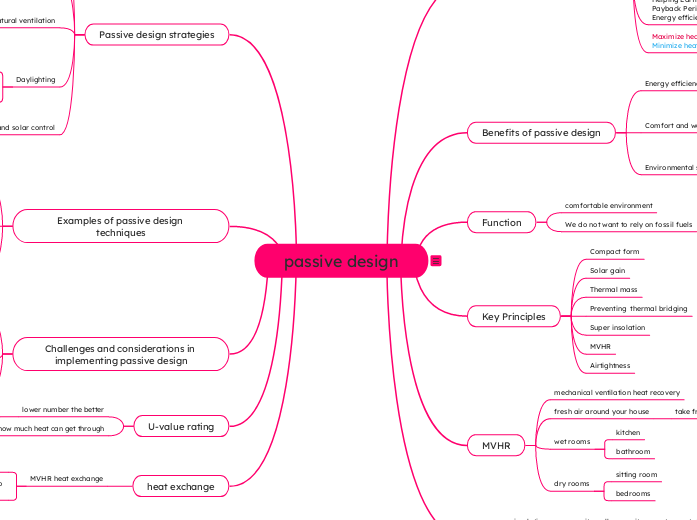passive design
Definition of passive design
Explanation of passive design principles
Importance of passive design in sustainable architecture
Energy efficient house
Will keep warm for a long period of time without constantly putting on heating
Helping Earth with fossil fuels +
Payback Period+
Energy efficient
Maximize heat gain
Minimize heat loss
Benefits of passive design
Energy efficiency
Reduction in heating and cooling costs
Decreased reliance on mechanical systems
Comfort and well-being
Natural ventilation and airflow
Optimal natural lighting
Environmental sustainability
Lower carbon footprint
Reduced greenhouse gas emissions
Function
comfortable environment
We do not want to rely on fossil fuels
Key Principles
Compact form
Solar gain
Thermal mass
Preventing thermal bridging
Super insolation
MVHR
Airtightness
MVHR
mechanical ventilation heat recovery
fresh air around your house
take fresh air from outside
wet rooms
kitchen
bathroom
dry rooms
sitting room
bedrooms
insulation
cavity wall=pump it
termostat
solar pannals-heat/electricity
phtotvaltic=electricty tubular-heat
Passive design strategies
Orientation and building layout
Maximizing solar gain in winter
Minimizing solar heat gain in summer
Insulation and thermal mass
Importance of insulation in reducing heat transfer
Utilizing thermal mass to regulate indoor temperature
Natural ventilation
Designing for cross ventilation
Incorporating operable windows and vents
Daylighting
Utilizing windows
skylights
and light shelves
Controlling glare and optimizing natural light
Shading and solar control
Using shading devices and overhangs
Incorporating reflective surfaces and low-E glass
Examples of passive design techniques
Passive solar design
Solar panels and solar water heating systems
Trombe walls and sunspaces
Passive cooling strategies
Green roofs and cool roofs
Natural ventilation techniques like stack effect
Passive lighting solutions
Light tubes and light shelves
Clerestory windows and reflective surfaces
Challenges and considerations in implementing passive design
Climate-specific design requirements
Adaptation to different climate zones
Balancing heating and cooling needs
Building codes and regulations
Compliance with energy efficiency standards
Overcoming potential barriers to implementation
Cost implications
U-value rating
lower number the better
0.15
how much heat can get through
heat exchange
MVHR heat exchange
takes fresh air from outside through heat exchanger and puts in inside
takes bad air from wet rooms and put it outside to prevent mold and odors through heat exchange
